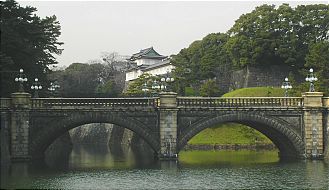Welcome to House, うち(家)!
 |
Imperial Palace こうきょ(皇居) According to Japanese mythology, Japan's first Emperor Jimmu was a descendant of the Sun Goddess Amaterasu Oomikami (天照大神). Jimmu was enthroned in the year 660 BC. Although the myths about the Sun Goddess and the beginning of the Imperial Family are not considered accurate in modern times, it is a commonly accepted fact that the emperors who have reigned over Japan for more than 1500 years have all descended from the same Imperial Family. The 1946 postwar and current Constitution of Japan states that the Emperor has only a symbolic function. He now mainly participates at ceremonies and diplomatic meetings, but has no effective political power. In 1989, Emperor Akihito became Japan's 125th emperor after the death of his father, Emperor Hirohito. He is married to Empress Michiko, who is the first empress who did not come from nobility. Their eldest son, Crown Prince Naruhito and his wife Crown Princess Masako have one daughter named Aiko. Prince Naruhito becomes Emperor of Japan in the spring of 2019 due to the abdication of his father, Emperor Akihito. The Imperial Family resides in the Imperial Palace in Tokyo. The current Imperial Palace is located at the former site of Edo Castle, a large park area surrounded by moats and massive stone walls in the center of Tokyo. It was originally the castle of the Tokugawa Shogun during the Tokugawa Era. The palace buildings and inner gardens are not open to the public except on January 2 (for a New Year's Greeting) and December 23 (for Emperor Akihito’s Birthday). On these dates, visitors are able to enter the inner palace grounds and see the members of the Imperial Family who make several public appearances on a balcony of the palace. |
Remember to keep in mind that fluency in Japanese (or any foreign language) does not happen overnight. It may seem to be a very slow process at times, but better fluency is only achieved with more practice and by seeking new ways to practice and use your new skills.
Can-Do for this unit:
- talk about your house (rooms and furnishings)
- talk about activities that happened in the past
- learn about homes in Japan
- continue to develop conversational skills in Japanese
You should keep in mind that during the course of this unit, House うち(家), you should spend time doing vocabulary activities and drilling vocabulary (flashcards) at least 15 minutes daily. You should practice writing kanji and kana or any other vocabulary that you are having difficulty learning.
![]() Graded Assignments shown in the Unit Content pages will have the checkmark icon next to the title.
Graded Assignments shown in the Unit Content pages will have the checkmark icon next to the title.
To locate the most current assignment instructions and to submit your completed work, please go to your Section Assignments folders in Schoology. You will complete the following types of graded assignments in this unit:
- Grammar Notes
- Oral Assignments
- Writing Assignments
- Discussion Assignments
- Speaking Assignments
- Section Quizzes
- TPR Quizzes
- Unit Exam
